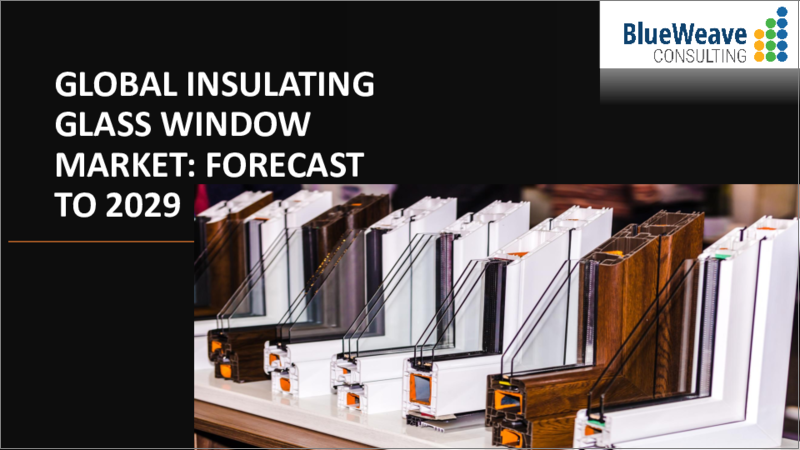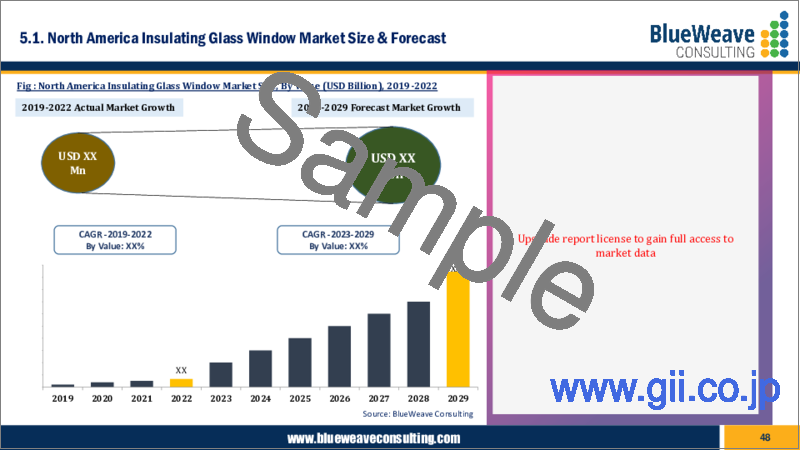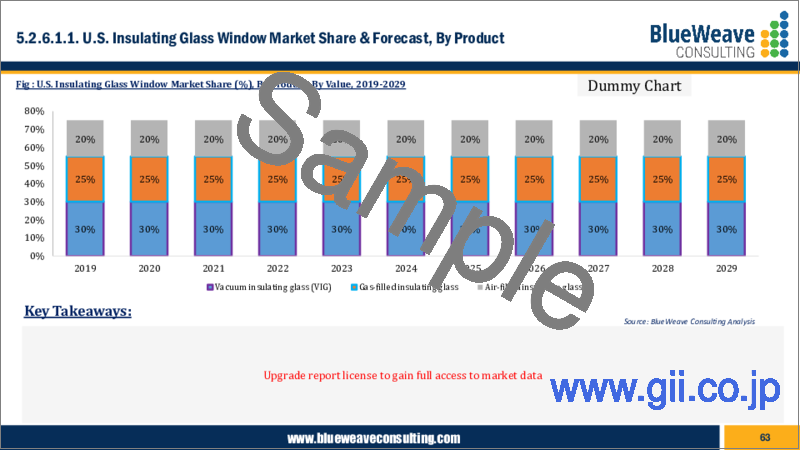|
|
市場調査レポート
商品コード
1237143
断熱ガラス窓の世界市場 - 規模、シェア、動向分析、機会、予測(2019年~2029年):製品別、板ガラスタイプ別、スペーサータイプ別、シーラントタイプ別、最終用途別、地域別Insulating Glass Window Market - Global Size, Share, Trend Analysis, Opportunity and Forecast Report, 2019-2029, Segmented By Product ; By Glazing Type ; By Spacer Type ; By Sealant Type ; By End Use ; By Region |
||||||
| 断熱ガラス窓の世界市場 - 規模、シェア、動向分析、機会、予測(2019年~2029年):製品別、板ガラスタイプ別、スペーサータイプ別、シーラントタイプ別、最終用途別、地域別 |
|
出版日: 2023年03月07日
発行: Blueweave Consulting
ページ情報: 英文 400 Pages
納期: 2~3営業日
|
- 全表示
- 概要
- 目次
世界の断熱ガラス窓の市場規模は、2022年の133億1,000万米ドルから2029年までに202億4,000万米ドルに達し、2023年~2029年の予測期間中にCAGRで6.26%の成長が予測されています。世界の建設部門における活動や取り組みの増加が、市場を牽引しています。
当レポートでは、世界の断熱ガラス窓市場について調査分析し、市場規模と予測、セグメント分析、地域分析、企業プロファイルなどを提供しています。
目次
第1章 調査の枠組み
第2章 エグゼクティブサマリー
第3章 世界の断熱ガラス窓市場の考察
- 業界バリューチェーン分析
- DROC分析
- 成長促進要因
- 抑制要因
- 機会
- 課題
- 技術の進歩/最近の発展
- 規制の枠組み
- ポーターのファイブフォース分析
第4章 世界の断熱ガラス窓市場の概要
- 市場規模と予測(2019年~2029年)
- 金額
- 市場シェアと予測
- 製品別
- 真空断熱ガラス(VIG)
- ガス入り断熱ガラス
- 空気入り断熱ガラス
- 板ガラスタイプ別
- 二重ガラス
- 三重ガラス
- その他
- スペーサータイプ別
- コールドエッジスペーサー
- ウォームエッジスペーサー
- シーラントタイプ別
- シリコン
- ポリスルフィド
- ホットメルトブチル
- ポリウレタン
- その他
- 最終用途別
- 住宅
- 商業
- 地域別
- 北米
- 欧州
- アジア太平洋
- ラテンアメリカ
- 中東・アフリカ
- 製品別
第5章 北米の断熱ガラス窓市場
- 市場規模と予測(2019年~2029年)
- 金額
- 市場シェアと予測
- 製品別
- 板ガラスタイプ別
- スペーサータイプ別
- シーラントタイプ別
- 最終用途別
- 国別
- 米国
- カナダ
第6章 欧州の断熱ガラス窓市場
- 市場規模と予測(2019年~2029年)
- 金額
- 市場シェアと予測
- 製品別
- 板ガラスタイプ別
- スペーサータイプ別
- シーラントタイプ別
- 最終用途別
- 国別
- ドイツ
- 英国
- イタリア
- フランス
- スペイン
- オランダ
- その他の欧州
第7章 アジア太平洋の断熱ガラス窓市場
- 市場規模と予測(2019年~2029年)
- 金額
- 市場シェアと予測
- 製品別
- 板ガラスタイプ別
- スペーサータイプ別
- シーラントタイプ別
- 最終用途別
- 国別
- 中国
- インド
- 日本
- 韓国
- オーストラリア・ニュージーランド
- インドネシア
- マレーシア
- シンガポール
- フィリピン
- ベトナム
- その他のアジア太平洋
第8章 ラテンアメリカの断熱ガラス窓市場
- 市場規模と予測(2019年~2029年)
- 金額
- 市場シェアと予測
- 製品別
- 板ガラスタイプ別
- スペーサータイプ別
- シーラントタイプ別
- 最終用途別
- 国別
- ブラジル
- メキシコ
- アルゼンチン
- ペルー
- その他のラテンアメリカ
第9章 中東・アフリカの断熱ガラス窓市場
- 市場規模と予測(2019年~2029年)
- 金額
- 市場シェアと予測
- 製品別
- 板ガラスタイプ別
- スペーサータイプ別
- シーラントタイプ別
- 最終用途別
- 国別
- サウジアラビア
- アラブ首長国連邦
- カタール
- クウェート
- 南アフリカ
- ナイジェリア
- アルジェリア
- その他の中東・アフリカ
第10章 競合情勢
- 主要企業とその製品のリスト
- 世界の断熱ガラス窓企業の市場シェア分析(2022年)
- 競合ベンチマーキング:経営パラメーター別
- 主な戦略的展開(合併、買収、パートナーシップなど)
第11章 世界の断熱ガラス窓市場に対するCOVID-19の影響
第12章 企業プロファイル(企業の概要、財務マトリックス、競合情勢、主な人材、主な競合、連絡先、戦略的見通し、SWOT分析)
- 3M
- AGC Inc.
- Compagnie De Saint-Gobain S.A.
- Dymax
- Glaston Corporation
- Guardian Industries
- H.B. Fuller Company
- Henkel AG & Co. KGaA
- Internorm, Nippon Sheet Glass Co., Ltd.
- Scheuten
- Viracon
- Yongan Adhesive Industry Co., Ltd.
- その他の著名な企業
第13章 主な戦略的推奨事項
第14章 調査手法
Global Insulating Glass Window Market Size Expands to Cross USD 20.2 Billion by 2029.
Global insulating glass window market is flourishing due to the strong demand for insulated glass in the architecture and construction industry owing to its several benefits, including temperature management, reduced reflection, and sun protection.
BlueWeave Consulting, a leading strategic consulting and market research firm, in its recent study, estimated the global insulating glass window market size at USD 13.31 billion in 2022. During the forecast period between 2023 and 2029, BlueWeave expects the global insulating glass window market size to grow at a CAGR of 6.26% reaching a value of USD 20.24 billion by 2029. The growing number of activities and initiatives in the global construction sector is driving the insulating glass window market. Currently, the industry is expected to expand due to an increase in sales of low-E coated insulating glass windows for newly constructed commercial structures to meet national environmental and energy challenges and reduce energy consumption even further. The growing desire to improve energy efficiency and lower electricity bills, particularly in cold and hot climates, will drive demand for insulating glass windows.
Global Insulating Glass Window Market - Overview:
An insulating glass window lowers heat transfer over a segment of the building envelope by joining several panes of glass into a single piece. The flow of heat and cold is also impeded by gas and numerous glass panes. It reduces the need for artificial air conditioning by regulating the temperature of the space and preventing air from escaping through windows.
Global Insulating Glass Window Market - By Sealant Type
Global insulating glass window market is segmented into Silicone, Polysulfide, Hot melt butyl, Polyurethane, and Others. The silicone segment holds a significant market share in the global market by sealant type. Silicone sealants are used to seal the joints and insulate panes to prevent air leakage between the windows. The increasing use of insulating glass windows is expected to propel the segment's growth. Silicone sealants are becoming more popular in the construction industry due to their numerous advantages, including extremely low-temperature flexibility, excellent electrical properties, oxidation and ozone resistance, excellent thermal and weather stability, high gas permeability, and physiological inertness.
Impact of COVID-19 on Global Insulating Glass Window Market
The coronavirus outbreak adversely affected the global insulated glass market. Because of the pandemic, governments across the countries have enacted stringent regulations, which have had an impact on the development of the insulated glass market. The main markets for insulated glass, such as the construction industry, have also ceased operations, resulting in a drop in global glass demand. Furthermore, the vast majority of raw materials suppliers in this industry were forced to close their doors, and the large suppliers shifted their focus to pandemic assistance.
Competitive Landscape:
Global insulating glass window market is fiercely competitive. Prominent players in the market include 3M, AGC Inc., Compagnie De Saint-Gobain S.A., Dymax, Glaston Corporation, Guardian Industries, H.B. Fuller Company, Henkel AG & Co. KGaA, Internorm, Nippon Sheet Glass Co., Ltd., Scheuten, Viracon, and Yongan Adhesive Industry Co., Ltd. These companies use various strategies, including increasing investments in their R&D activities, mergers, and acquisitions, joint ventures, collaborations, licensing agreements, and new product and service releases to further strengthen their position in the global insulating glass window market.
The in-depth analysis of the report provides information about growth potential, upcoming trends, and statistics of Global Insulating Glass Window Market. It also highlights the factors driving forecasts of total market size. The report promises to provide recent technology trends in Global Insulating Glass Window Market and industry insights to help decision-makers make sound strategic decisions. Furthermore, the report also analyzes the growth drivers, challenges, and competitive dynamics of the market.
Table of Contents
1. Research Framework
- 1.1. Research Objective
- 1.2. Product Overview
- 1.3. Market Segmentation
2. Executive Summary
3. Global Insulating Glass Window Market Insights
- 3.1. Industry Value Chain Analysis
- 3.2. DROC Analysis
- 3.2.1. Growth Drivers
- 3.2.1.1. Optimal Energy-saving Performance
- 3.2.1.2. Advancement in Technology
- 3.2.2. Restraints
- 3.2.2.1. Lack of Data Safety
- 3.2.3. Opportunities
- 3.2.3.1. Growing Trend of Lightweight Vehicles
- 3.2.4. Challenges
- 3.2.4.1. High Fuel Consumption in Glass Manufacturing
- 3.2.1. Growth Drivers
- 3.3. Technology Advancements/Recent Developments
- 3.4. Regulatory Framework
- 3.5. Porter's Five Forces Analysis
- 3.5.1. Bargaining Power of Suppliers
- 3.5.2. Bargaining Power of Buyers
- 3.5.3. Threat of New Entrants
- 3.5.4. Threat of Substitutes
- 3.5.5. Intensity of Rivalry
4. Global Insulating Glass Window Market Overview
- 4.1. Market Size & Forecast, 2019-2029
- 4.1.1. By Value (USD Million)
- 4.2. Market Share & Forecast
- 4.2.1. By Product
- 4.2.1.1. Vacuum insulating glass (VIG)
- 4.2.1.2. Gas filled insulating glass
- 4.2.1.3. Air filled insulating glass
- 4.2.2. By Glazing Type
- 4.2.2.1. Double glazed
- 4.2.2.2. Triple glazed
- 4.2.2.3. Others
- 4.2.3. By Spacer Type
- 4.2.3.1. Cold edge spacer
- 4.2.3.2. Warm edge spacer
- 4.2.4. By Sealant Type
- 4.2.4.1. Silicone
- 4.2.4.2. Polysulfide
- 4.2.4.3. Hot melt butyl
- 4.2.4.4. Polyurethane
- 4.2.4.5. Others
- 4.2.5. By End Use
- 4.2.5.1. Residential
- 4.2.5.2. Commercial
- 4.2.6. By Region
- 4.2.6.1. North America
- 4.2.6.2. Europe
- 4.2.6.3. Asia Pacific (APAC)
- 4.2.6.4. Latin America (LATAM)
- 4.2.6.5. Middle East and Africa (MEA)
- 4.2.1. By Product
5. North America Insulating Glass Window Market
- 5.1. Market Size & Forecast, 2019-2029
- 5.1.1. By Value (USD Million)
- 5.2. Market Share & Forecast
- 5.2.1. By Product
- 5.2.2. By Glazing Type
- 5.2.3. By Spacer Type
- 5.2.4. By Sealant Type
- 5.2.5. By End Use
- 5.2.6. By Country
- 5.2.6.1. US
- 5.2.6.1.1. By Product
- 5.2.6.1.2. By Glazing Type
- 5.2.6.1.3. By Spacer Type
- 5.2.6.1.4. By Sealant Type
- 5.2.6.1.5. By End Use
- 5.2.6.2. Canada
- 5.2.6.2.1. By Product
- 5.2.6.2.2. By Glazing Type
- 5.2.6.2.3. By Spacer Type
- 5.2.6.2.4. By Sealant Type
- 5.2.6.2.5. By End Use
6. Europe Insulating Glass Window Market
- 6.1. Market Size & Forecast, 2019-2029
- 6.1.1. By Value (USD Million)
- 6.2. Market Share & Forecast
- 6.2.1. By Product
- 6.2.2. By Glazing Type
- 6.2.3. By Spacer Type
- 6.2.4. By Sealant Type
- 6.2.5. By End Use
- 6.2.6. By Country
- 6.2.6.1. Germany
- 6.2.6.1.1. By Product
- 6.2.6.1.2. By Glazing Type
- 6.2.6.1.3. By Spacer Type
- 6.2.6.1.4. By Sealant Type
- 6.2.6.1.5. By End Use
- 6.2.6.2. UK
- 6.2.6.2.1. By Product
- 6.2.6.2.2. By Glazing Type
- 6.2.6.2.3. By Spacer Type
- 6.2.6.2.4. By Sealant Type
- 6.2.6.2.5. By End Use
- 6.2.6.3. Italy
- 6.2.6.3.1. By Product
- 6.2.6.3.2. By Glazing Type
- 6.2.6.3.3. By Spacer Type
- 6.2.6.3.4. By Sealant Type
- 6.2.6.3.5. By End Use
- 6.2.6.4. France
- 6.2.6.4.1. By Product
- 6.2.6.4.2. By Glazing Type
- 6.2.6.4.3. By Spacer Type
- 6.2.6.4.4. By Sealant Type
- 6.2.6.4.5. By End Use
- 6.2.6.5. Spain
- 6.2.6.5.1. By Product
- 6.2.6.5.2. By Glazing Type
- 6.2.6.5.3. By Spacer Type
- 6.2.6.5.4. By Sealant Type
- 6.2.6.5.5. By End Use
- 6.2.6.6. Netherlands
- 6.2.6.6.1. By Product
- 6.2.6.6.2. By Glazing Type
- 6.2.6.6.3. By Spacer Type
- 6.2.6.6.4. By Sealant Type
- 6.2.6.6.5. By End Use
- 6.2.6.7. Rest of Europe
- 6.2.6.7.1. By Product
- 6.2.6.7.2. By Glazing Type
- 6.2.6.7.3. By Spacer Type
- 6.2.6.7.4. By Sealant Type
- 6.2.6.7.5. By End Use
7. Asia-Pacific Insulating Glass Window Market
- 7.1. Market Size & Forecast, 2019-2029
- 7.1.1. By Value (USD Million)
- 7.2. Market Share & Forecast
- 7.2.1. By Product
- 7.2.2. By Glazing Type
- 7.2.3. By Spacer Type
- 7.2.4. By Sealant Type
- 7.2.5. By End Use
- 7.2.6. By Country
- 7.2.6.1. China
- 7.2.6.1.1. By Product
- 7.2.6.1.2. By Glazing Type
- 7.2.6.1.3. By Spacer Type
- 7.2.6.1.4. By Sealant Type
- 7.2.6.1.5. By End Use
- 7.2.6.2. India
- 7.2.6.2.1. By Product
- 7.2.6.2.2. By Glazing Type
- 7.2.6.2.3. By Spacer Type
- 7.2.6.2.4. By Sealant Type
- 7.2.6.2.5. By End Use
- 7.2.6.3. Japan
- 7.2.6.3.1. By Product
- 7.2.6.3.2. By Glazing Type
- 7.2.6.3.3. By Spacer Type
- 7.2.6.3.4. By Sealant Type
- 7.2.6.3.5. By End Use
- 7.2.6.4. South Korea
- 7.2.6.4.1. By Product
- 7.2.6.4.2. By Glazing Type
- 7.2.6.4.3. By Spacer Type
- 7.2.6.4.4. By Sealant Type
- 7.2.6.4.5. By End Use
- 7.2.6.5. Australia & New Zealand
- 7.2.6.5.1. By Product
- 7.2.6.5.2. By Glazing Type
- 7.2.6.5.3. By Spacer Type
- 7.2.6.5.4. By Sealant Type
- 7.2.6.5.5. By End Use
- 7.2.6.6. Indonesia
- 7.2.6.6.1. By Product
- 7.2.6.6.2. By Glazing Type
- 7.2.6.6.3. By Spacer Type
- 7.2.6.6.4. By Sealant Type
- 7.2.6.6.5. By End Use
- 7.2.6.7. Malaysia
- 7.2.6.7.1. By Product
- 7.2.6.7.2. By Glazing Type
- 7.2.6.7.3. By Spacer Type
- 7.2.6.7.4. By Sealant Type
- 7.2.6.7.5. By End Use
- 7.2.6.8. Singapore
- 7.2.6.8.1. By Product
- 7.2.6.8.2. By Glazing Type
- 7.2.6.8.3. By Spacer Type
- 7.2.6.8.4. By Sealant Type
- 7.2.6.8.5. By End Use
- 7.2.6.9. Philippines
- 7.2.6.9.1. By Product
- 7.2.6.9.2. By Glazing Type
- 7.2.6.9.3. By Spacer Type
- 7.2.6.9.4. By Sealant Type
- 7.2.6.9.5. By End Use
- 7.2.6.10. Vietnam
- 7.2.6.10.1. By Product
- 7.2.6.10.2. By Glazing Type
- 7.2.6.10.3. By Spacer Type
- 7.2.6.10.4. By Sealant Type
- 7.2.6.10.5. By End Use
- 7.2.6.11. Rest of APAC
- 7.2.6.11.1. By Product
- 7.2.6.11.2. By Glazing Type
- 7.2.6.11.3. By Spacer Type
- 7.2.6.11.4. By Sealant Type
- 7.2.6.11.5. By End Use
8. Latin America Insulating Glass Window Market
- 8.1. Market Size & Forecast, 2019-2029
- 8.1.1. By Value (USD Million)
- 8.2. Market Share & Forecast
- 8.2.1. By Product
- 8.2.2. By Glazing Type
- 8.2.3. By Spacer Type
- 8.2.4. By Sealant Type
- 8.2.5. By End Use
- 8.2.6. By Country
- 8.2.6.1. Brazil
- 8.2.6.1.1. By Product
- 8.2.6.1.2. By Glazing Type
- 8.2.6.1.3. By Spacer Type
- 8.2.6.1.4. By Sealant Type
- 8.2.6.1.5. By End Use
- 8.2.6.2. Mexico
- 8.2.6.2.1. By Product
- 8.2.6.2.2. By Glazing Type
- 8.2.6.2.3. By Spacer Type
- 8.2.6.2.4. By Sealant Type
- 8.2.6.2.5. By End Use
- 8.2.6.3. Argentina
- 8.2.6.3.1. By Product
- 8.2.6.3.2. By Glazing Type
- 8.2.6.3.3. By Spacer Type
- 8.2.6.3.4. By Sealant Type
- 8.2.6.3.5. By End Use
- 8.2.6.4. Peru
- 8.2.6.4.1. By Product
- 8.2.6.4.2. By Glazing Type
- 8.2.6.4.3. By Spacer Type
- 8.2.6.4.4. By Sealant Type
- 8.2.6.4.5. By End Use
- 8.2.6.5. Rest of LATAM
- 8.2.6.5.1. By Product
- 8.2.6.5.2. By Glazing Type
- 8.2.6.5.3. By Spacer Type
- 8.2.6.5.4. By Sealant Type
- 8.2.6.5.5. By End Use
9. Middle East & Africa Insulating Glass Window Market
- 9.1. Market Size & Forecast, 2019-2029
- 9.1.1. By Value (USD Million)
- 9.2. Market Share & Forecast
- 9.2.1. By Product
- 9.2.2. By Glazing Type
- 9.2.3. By Spacer Type
- 9.2.4. By Sealant Type
- 9.2.5. By End Use
- 9.2.6. By Country
- 9.2.6.1. Saudi Arabia
- 9.2.6.1.1. By Product
- 9.2.6.1.2. By Glazing Type
- 9.2.6.1.3. By Spacer Type
- 9.2.6.1.4. By Sealant Type
- 9.2.6.1.5. By End Use
- 9.2.6.2. UAE
- 9.2.6.2.1. By Product
- 9.2.6.2.2. By Glazing Type
- 9.2.6.2.3. By Spacer Type
- 9.2.6.2.4. By Sealant Type
- 9.2.6.2.5. By End Use
- 9.2.6.3. Qatar
- 9.2.6.3.1. By Product
- 9.2.6.3.2. By Glazing Type
- 9.2.6.3.3. By Spacer Type
- 9.2.6.3.4. By Sealant Type
- 9.2.6.3.5. By End Use
- 9.2.6.4. Kuwait
- 9.2.6.4.1. By Product
- 9.2.6.4.2. By Glazing Type
- 9.2.6.4.3. By Spacer Type
- 9.2.6.4.4. By Sealant Type
- 9.2.6.4.5. By End Use
- 9.2.6.5. South Africa
- 9.2.6.5.1. By Product
- 9.2.6.5.2. By Glazing Type
- 9.2.6.5.3. By Spacer Type
- 9.2.6.5.4. By Sealant Type
- 9.2.6.5.5. By End Use
- 9.2.6.6. Nigeria
- 9.2.6.6.1. By Product
- 9.2.6.6.2. By Glazing Type
- 9.2.6.6.3. By Spacer Type
- 9.2.6.6.4. By Sealant Type
- 9.2.6.6.5. By End Use
- 9.2.6.7. Algeria
- 9.2.6.7.1. By Product
- 9.2.6.7.2. By Glazing Type
- 9.2.6.7.3. By Spacer Type
- 9.2.6.7.4. By Sealant Type
- 9.2.6.7.5. By End Use
- 9.2.6.8. Rest of MEA
- 9.2.6.8.1. By Product
- 9.2.6.8.2. By Glazing Type
- 9.2.6.8.3. By Spacer Type
- 9.2.6.8.4. By Sealant Type
- 9.2.6.8.5. By End Use
10. Competitive Landscape
- 10.1. List of Key Players and Their Offerings
- 10.2. Global Insulating Glass Window Company Market Share Analysis, 2022
- 10.3. Competitive Benchmarking, By Operating Parameters
- 10.4. Key Strategic Developments (Mergers, Acquisitions, Partnerships, etc.)
11. Impact of Covid-19 on Global Insulating Glass Window Market
12. Company Profile (Company Overview, Financial Matrix, Competitive Landscape, Key Personnel, Key Competitors, Contact Address, Strategic Outlook, SWOT Analysis)
- 12.1. 3M
- 12.2. AGC Inc.
- 12.3. Compagnie De Saint-Gobain S.A.
- 12.4. Dymax
- 12.5. Glaston Corporation
- 12.6. Guardian Industries
- 12.7. H.B. Fuller Company
- 12.8. Henkel AG & Co. KGaA
- 12.9. Internorm, Nippon Sheet Glass Co., Ltd.
- 12.10. Scheuten
- 12.11. Viracon,
- 12.12. Yongan Adhesive Industry Co., Ltd.
- 12.13. Other Prominent Players
13. Key Strategic Recommendations
14. Research Methodology
- 14.1. Qualitative Research
- 14.1.1. Primary & Secondary Research
- 14.2. Quantitative Research
- 14.3. Market Breakdown & Data Triangulation
- 14.3.1. Secondary Research
- 14.3.2. Primary Research
- 14.4. Breakdown of Primary Research Respondents, By Region
- 14.5. Assumptions & Limitations




